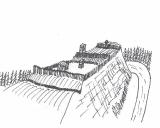The Refuge (2/4)
The Refuge
Upon arrival, to my surprise I saw a sign adjacent to the road. It had not been erected by the official monument protection authorities but by the county. It showed historical places in the county and even described a former refuge at the place in question. Such signs are extremely unusual in my part of the world. Usually these places lay dormant while few people know of their existence or care about them, not to talk about erecting signs.
The sign explained “Because finds and masonry are missing one has to imagine the refuge as a wood-earth construction of the early middle ages. Written sources are unknown so there are no further hints for dating.” The text was complemented with a very nice drawing of the refuge showing a massive wooden construction with watchtowers and small buildings surrounded by palisades. There were three defence lines of trench and palisade.
I made a sketch using pen and paper. Though it is not as pretty as the original it might be sufficient for the reader to get an idea.
The refuge place in question was a triangle shaped patch of land at the rim of a plateau some 10 to 15 m above the river below. Two sides of the triangle were steep hangs. To fortify this place it is only necessary to defend the third side. This is why these places where chosen in the old days when it came to erect a refuge. Usually the third side is protected by several trench-palisade combinations. Today all traces of wood have disappeared with the possible exception of subterranean remains but the trenches are still visible.
Castles and refuges are similar constructions with different purposes. While both were designed to withstand an attack the purpose of a refuge was to hide while the purpose of a castle was to show power and be visible, to see and to be seen.
Without detector I walked towards this place. In the woods there were two men who wore orange safety clothing and were obviously busy with forest work. When I asked for the former castle they pointed to a patch of land just some 50 m away. The older men of the two was some 70 years old. He said that when he was a young boy men from the village dug for treasure inside this structure. They did not find anything, he added.
To get a feeling for this place the rest of the day was spend wandering around without any gear. The trenches were still some 1.5 m deep and some 15 to 80 m long. I even found the depression that resulted from the mentioned treasure recovery attempt in the 1940s. It had a square shape, some 1.5 m square and some 30 cm deep, as far as I remember.
So much so good. There was a historical place and a sign informing all visitors about his former appearance. There is just one problem. The sign is wrong. This hill never carried a massive wooden structure as the one depicted on the drawing. Why do I know? Because a systematic detector search performed at a later stage did not reveal a single nail.
(C) Thorsten Straub www.metal-detecting.de 2006-2019.
